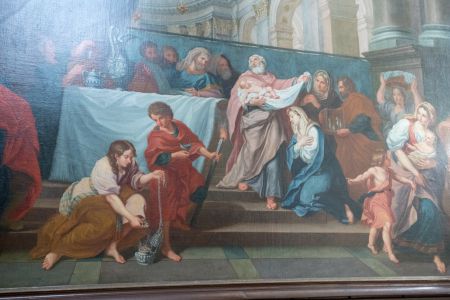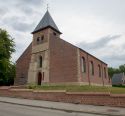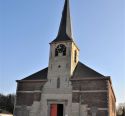Abbey church | XVIII-XIX | Baroque | Catholic Church



Map
Opening hours
01 January - 31 December
Mon 9.00 - 17.00
Tue 9.00 - 17.00
Wed 9.00 - 17.00
Thu 9.00 - 17.00
Fri 9.00 - 17.00
Sat 9.00 - 17.00
Sun 9.00 - 17.00
Pilgrimage to Sint Cornelius
Guided tour
+32 54 33 20 25
vandaele.alexander@gmail.be
Religious offices
Description
This Baroque church with three naves, of brick and Lede sandstone, was consecrated in 1727 as the abbey church of the Premonstratensians, after an architectural history of 100 years. Since 1813 it has served as a parish church, but before the Abbot Ferdinand Vander Haeghen had envisaged a dual use of the church: the choir and the transept would serve as the abbey church, while the nave would receive the pilgrims.
The square tower and its hexagonal lantern were added only in 1825-1844 by the architect Lodewijk Roelandt (1786-1864).
This church is one of the most important houses of prayer in the country. Culturally, it is the most complete creation in the entire region of Dendre thanks to its richly decorated interior and its surprising homogeneity.
The stalls of the choir and the cathedra date from the 17th century and come from the old parish church, destroyed in 1816-1828. The remainder of the decoration, in the Baroque style and the Regency style, came into being under the direction of Abbot Vander Haeghen during the first half of the 18th century.
Thus the church owes its renown to the remarkable set of panelling, ordered in 1736 from the Mechelen sculptor Theodore Verhaegen who executed one of the two sumptuous confessionals, as well as the wainscoting of the lateral naves that include ten scenes from the life of Saint Cornelius and Saint Cyprian, to whom the ancient abbey was consecrated.
The lower part of the central dome, adorned with splendid stuccos, should also be admired.
KIKIRPA : Photo-library online
Photos
Media
Remarkable elements
The panelling of the side aisles
On entering the church, many visitors are quite impressed by the oak wall panelling of the side aisles. It contains four large paintings, alternated by six sculpted bas-reliefs, all surrounded by decorative frames in the Regency style.
On the south side, ten of the most important events in the life of St. Cornelius are depicted, on the north side ten important events in the life of St. Cyprian. Together with Our Lady they were the patron saints of the abbey.
In the books on the presentation chairs detailed information can be found about all art objects (paintings, wood carvings, brotherhood lists, organ, altars, ...). These 'information points' are scattered throughout the church and can be consulted freely.
Relic shrine of St. Cornelius and St. Cyprian
One of the highlights of the church is the reliquary of St. Cornelius and St. Cyprian. The reliquary (by Brussels masters, 1643-1644, covered with gilded copper and driven silver) is in the shape of a baroque sarcophagus, rests on four claw legs and is abundantly decorated with acanthus leaves between which angels play. On each wall there is a historical relief concerning the torture, the glorification and the salutary intervention of the two saints. The relic horn covered with silver on top of the shrine is probably from 1586.
Through the centuries the shrine was carried around in processions. It is still central to the worship of St. Cornelius during the Whitsun weekend.
Choir
The choir section of this former abbey church is strongly expanded. It is equipped with richly decorated oak choir stalls that were transferred from a temporary chapel (1638).
At the entrance to the high choir is an equally richly sculpted communion bench (in oak, mid 18th century) with four historical reliefs to behold. It is striking that the theme 'Hope, Faith and Love' was depicted both in the centrally placed choral lectern (made of three types of marble) and in the figuration of the marbled and gilded high altar.
High above the high altar is the image of the Assumption of Mary, patroness of the church since 1813.
Altar dedicated to Our Lady
In one of the side chapels, an extension of the northern transept, stands an altar (in marbled and gilded wood, 1730) that was originally erected for the worship of the Holy Trinity and Saint Joseph. After 1812, when the abbey church was transformed into a parish church, the altar was dedicated to Our Lady. Especially special is the white marble statue of Our Lady with the Child Jesus (18th century). During the French rule the inhabitants of Ninove kept this statue hidden. In 1849 they donated it to the church.
Organ
The former abbey church of Ninove contains one of the most beautiful and largest baroque organs in the Southern Netherlands. J. B. de Forceville built the instrument in 1728. His pupil Gilles le Blas added an echo work in 1752. The organ case contains extensive sculptural decorations: musical instruments, angels making music, medallions with saintly figures, ... On the central collection of pipes is a statue of the seated St. Cecilia, playing on a small organ keyboard.
Since 1978 several restoration works have been carried out. Thus the organ was again in the spotlight, which led to a number of digital recordings and the issue of a stamp.
Confessionnal
The confessional (in oak, 1736 - 1738) to the left of the organ case is so large that it covers the entire width of the aisle. The plastic effect in the Regency style is of a very high quality.
The iconographic programme is the sublimated expression of confession. The priest's chair, flanked by two life-sized angels, is conceived as a throne, covered by a canopy with pleated curtains. Higher up, kneeling, exemplary for their repentance, Saint Peter and the penitent Mary Magdalene with their respective attributes. On the crown is Christ as Salvator Mundi, the hands spread open as a sign of mercy.


























